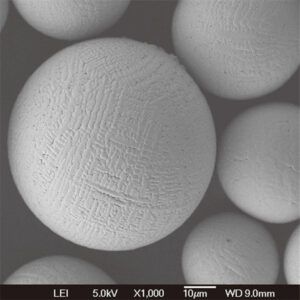选择性激光熔融(SLM)是一种 快速成型制造 或三维打印技术,使用激光将金属粉末逐层熔化成固体部件。最终零件的特性由所用金属粉末的特性决定。本文全面介绍了 SLM 粉末的成分、特性、应用、规格、价格、利弊等。
选择性激光熔化粉末概述
选择性激光熔化粉末,又称 SLM 粉末,是 SLM 快速成型制造工艺中使用的原材料。SLM 使用高功率激光将粉末状金属合金熔化并融合成完全致密的三维零件。
SLM 粉末是细金属粉末,尺寸通常在 15 到 45 微米之间。最常见的 SLM 粉末是基于铝、钛、镍、钴和不锈钢的合金。粉末的成分和粒度分布决定了选择性激光熔融打印部件的特性。
要生产出具有所需机械性能、精度、表面光洁度和微观结构的高质量零件,选择正确的 SLM 粉末至关重要。本指南详细介绍了不同类型的 SLM 粉末、其应用、规格、价格、优缺点以及主要的全球供应商。
SLM 粉末的主要特点
- 超细粉末粒度为 15 至 45 微米,用于精确激光熔化
- 促进粉末流动性的球形形态
- 化学成分纯净,可最大限度地减少瑕疵
- 控制粒度分布,防止偏析
- 惰性气体雾化生产方法
- 添加合金以增强性能
- 可能包括专有涂层,以改善流动性和熔融性
表 1:选择性激光熔化粉末的类型
| 粉末类型 | 普通合金 | 特点 |
|---|---|---|
| 铝质 | AlSi10Mg, AlSi12, AlSi7Mg0.6 | 密度低,导热性好 |
| 钛 | Ti6Al4V、Ti6Al4V ELI、TiAl | 高强度、生物相容性 |
| 镍 | 铬镍铁合金 718、铬镍铁合金 625 | 耐热性和耐腐蚀性 |
| 钴铬合金 | 钴铬合金、钴铬钼合金 | 生物相容性好,硬度高 |
| 工具钢 | H13,马氏体时效钢 | 硬度高、耐磨 |
| 不锈钢 | 316L、17-4PH、420 | 耐腐蚀、高强度 |
SLM 粉末的成分
SLM 粉末是由各种合金通过气体雾化制成的球形金属粉末。其成分决定了打印部件的材料特性。
表 2:常见 SLM 粉末合金的成分
| 合金 | 典型构成 |
|---|---|
| AlSi10Mg | 90% Al,10% Si,0.5% Mg |
| Ti6Al4V | 90% Ti、6% Al、4% V |
| 铬镍铁合金 718 | 50% 镍、19% 铬、18% 铁、5% 铌 |
| 钴铬钼合金 | 60% Co、30% Cr、7% Mo |
| 316L 不锈钢 | 70% 铁、17% 铬、12% 镍、2% 钼 |
SLM 粉末中的主要合金元素包括
- 铝 - 降低熔点,增加导热性
- 硅 - 改善流动性和可焊性
- 镁 - 强化剂
- 钛 - 生物相容性好,强度高
- 铝 - 钛合金中的α和β稳定剂
- 钒 - 钛合金中的β稳定剂
- 镍 - 抗腐蚀性、延展性
- 铬 - 抗氧化性和抗腐蚀性
- 铁 - 增加超级合金的强度
- 铌 - 超耐热合金中的强化元素
- 钼 - 超级合金中的固溶强化
- 钴 - 增强高温强度
最大限度地减少微量杂质,从而降低 SLM 印刷元件的缺陷。
SLM 粉末的特性
SLM 粉末的特性直接影响 3D 打印部件的特性。所需的特性包括良好的流动性、高纯度和优化的粒度分布。
表 3: SLM 粉末的主要特性
| 物业 | 典型范围 | 重要意义 |
|---|---|---|
| 颗粒大小 | 15 - 45 微米 | 细节精确度、分辨率 |
| 粒子形状 | 球形 | 改善流动性 |
| 流动性 | 优秀 | 防止粉末结块 |
| 表观密度 | 高于 50% 理论密度 | 提高激光吸收率和致密性 |
| 水龙头密度 | 理论密度高达 65% | 流动性、包装密度指标 |
| 剩余氧气 | <0.1 wt% | 防止氧化缺陷 |
| 残余氮 | <0.04 wt% | 防止氮化物夹杂 |
| 残碳 | <0.03 wt% | 防止碳化物沉淀 |
此外,SLM 粉末还具有优化的粒度分布,粒度范围小,可防止偏析问题。大多数 SLM 用粉末的 D10 和 D90 值在 10 到 20 微米之间。
SLM 粉末的特性(如粉末床密度、流动性、铺展性和可回收性)决定了印刷部件的质量。粉末的设计就是为了平衡这些因素。
SLM 粉末的应用
SLM 粉末用于打印各行各业的功能性金属零件:
表 4:选择性激光熔化粉末的应用
| 行业 | 常见应用 | 使用的典型材料 |
|---|---|---|
| 航空航天 | 涡轮叶片、火箭喷嘴 | 铬镍铁合金、钛 |
| 汽车 | 部件轻量化、定制几何形状 | 铝、工具钢 |
| 医疗 | 牙科盖板、种植体、手术工具 | 钛、钴铬 |
| 通用工程 | 快速原型、工具、最终使用部件 | 不锈钢、工具钢 |
SLM 用于零件生产的主要优势包括
- 能够制造铸造或机加工无法实现的复杂几何形状
- 按需定制零件,无需硬性工具
- 通过优化功能设计减轻重量
- 将组件合并为单一部件
- 从设计到部件的快速周转时间
SLM 适用于各行各业中小批量最终用途金属部件的生产。
SLM 粉末的规格
SLM 粉末必须在成分、粒度分布、形态、流动特性、表观密度、污染程度和微观结构方面满足严格的规格要求。
表 5:选择性激光熔化粉末的典型规格
| 参数 | 典型规格 | 测试方法 |
|---|---|---|
| 粉末成分 | 符合合金规格限制 | ICP-OES 化学分析 |
| 颗粒大小 | D10: 10-25 μm <br> D50: 20-35 μm <br> D90: 30-45 μm | 激光衍射 |
| 粒子形状 | >80% 球形,卫星极少 | 扫描电子显微镜成像 |
| 表观密度 | >50% 的合金理论密度 | 霍尔流量计 |
| 水龙头密度 | 理论密度高达 65% | 水龙头密度测试仪 |
| 流动性 | 倾斜角 <30 | 霍尔流量计 |
| 剩余氧气 | <0.1 wt% | 惰性气体聚变分析 |
| 残余氮 | <0.04 wt% | 惰性气体聚变分析 |
| 残碳 | <0.03 wt% | 燃烧红外探测 |
领先的 SLM 粉末供应商拥有内部粉末表征设施,可确保每批粉末在交付给客户之前都符合这些参数。
选择性激光熔化粉末的定价
SLM 粉末的成本取决于合金成分、质量、供应商、购买数量和地理区域。以下是一些典型的粉末定价:
表 6:常用 SLM 粉末合金的指示性定价范围
| 合金 | 每公斤价格 |
|---|---|
| AlSi10Mg 铝合金 | $50 – $120 |
| Ti6Al4V 钛合金 | $350 – $600 |
| 铬镍铁合金 718 | $150 – $250 |
| 不锈钢 316L | $50 – $100 |
| 钴铬合金 | $110 – $250 |
钛等活性合金的价格最高,铝和不锈钢等商品合金的价格最低。航空航天级合金的价格高于传统合金。SLM 粉末供应商可提供批量采购折扣。
总体而言,材料成本占金属 AM 零件总成本的 15-30%。粉末本身占材料成本的主要部分。优化未熔化粉末的再利用有助于降低零件的平均成本。
SLM 粉末的主要供应商
许多公司提供专为 SLM 快速成型制造设计的气体原子化金属粉末。一些领先的全球供应商包括
表 7:选择性激光熔化粉末的主要供应商
| 公司名称 | 总部 | 关键合金 |
|---|---|---|
| AP&C | 加拿大 | 钛、铝、钴合金 |
| 木匠添加剂 | 美国 | 钛、铝、钴、铜合金 |
| EOS | 德国 | 钛、铝、镍合金 |
| 山特维克鹗 | 英国 | 钛、铝、镍、不锈钢、工具钢 |
| SLM 解决方案 | 德国 | 钛、铝、镍、钴合金 |
| 林德 | 德国 | 钛、铝、不锈钢、工具钢 |
| 普莱克斯 | 美国 | 钛、钴、镍合金 |
| LPW 技术 | 英国 | 钛、铝、钴铬合金、铬镍铁合金 |
这些公司在雾化技术和先进的表征技术方面进行了投资,以确保 SLM 粉末符合 3D 打印高质量零件的严格要求。它们为 SLM 量身定制了多种材料选择。
SLM 粉末的优缺点
表 8:选择性激光熔化粉末的优点和局限性
| 优点 | 缺点 |
|---|---|
| 尺寸非常小,分辨率高 | 与铸造/机加工相比,合金选择有限 |
| 良好的流动特性 | 钛等反应性合金易受污染 |
| 球形形态,卫星数量少 | 潮湿敏感性要求小心处理 |
| 化学纯净,最大限度地减少缺陷 | 金属粉末危害健康 |
| 可控粒度分布 | 成本高于标准粉末 |
| 为 SLM 设计的定制合金 | 某些合金的供应商和供应有限 |
| 惰性气体雾化可避免氧化 | 未使用的粉末必须重新使用而不是丢弃 |
优点
- SLM 粉末的粒度为 15-45 微米,可以打印出非常高的分辨率和非常小的特征。
- 球形颗粒形状和良好的流动性可防止粉末聚集和印刷过程中的进料问题。
- 高化学纯度可最大限度地减少印刷部件中的夹杂物和空洞等缺陷。
- 粒度分布经过优化,可防止偏析,确保熔化均匀。
- 专业供应商为 SLM 应用量身定制合金成分。
- 惰性气体雾化可避免粉末氧化。
缺点
- 与传统制造方法相比,用于 SLM 的成熟合金较少。
- 钛等反应性合金需要特殊处理,以防止污染,从而增加成本。
- SLM 材料为细小粉末,在储存和处理过程中对吸湿很敏感。
- 金属粉末具有粉尘爆炸和危害健康等风险,需要采取安全预防措施。
- 由于采用专门的生产工艺,SLM 合金的成本大大高于标准粉末等级。
- 某些合金的供应商很少,这限制了材料的供应和质量。
- 出于可持续发展和成本因素的考虑,未熔化的粉末不能简单地丢弃,必须重复使用。
如何选择 SLM 粉末
为某项应用选择最佳 SLM 粉末需要考虑以下因素:
- 部件功能 - 机械要求、应力、运行条件
- 合金特性 - 强度、硬度、延展性、耐热性
- 后期处理需求 - 热处理响应、机加工性能
- 工艺因素 - 粉末床密度、激光吸收、流动性
- 成本因素 - 材料价格、设备影响
零件功能是合金选择的主要依据。关键的高应力零件需要能达到最大密度和机械性能的粉末。而不太重要的原型设计应用则需要更大的灵活性。
打印速度、可达到的精度和表面光洁度等工艺因素也取决于粉末。在实际打印机上对候选材料进行基准测试,以确定最佳匹配。
成本起着关键作用。用于航空航天应用的高性能合金要比传统牌号昂贵得多。独特的合金可能只能从单一供应商处获得。
根据材料性能和成本全面评估应用要求,从而选择最佳的 SLM 粉末。
如何储存和处理 SLM 粉末
小心处理和储存 SLM 粉末对防止材料降解和确保高质量打印部件至关重要:
- 将未开封的容器存放在阴凉、干燥的地方,避免阳光照射和潮湿。避免过热。
- 只能在氧气含量低于 10 ppm 的惰性手套箱中打开粉末容器,以防止氧化。
- 在手套箱内转移粉末时要适当接地,以避免静电积聚。戴上丁腈手套。
- 储存时要密封容器。只能使用原装容器,不能使用塑料袋。
- 对于大容量粉末,可将其储存在配有集成惰性气体系统的机器中。
- 重复使用前,用建议的筛网筛分粉末,以破碎结块并去除杂质。
- 必要时,使用粉末干燥箱和真空热脱气器来降低水分含量。
- 丢弃用过的粉末时,用水打湿,防止空气中的粉尘危害,并作为危险废物处理。
- 遵守处理细金属粉末的所有安全预防措施,包括个人防护设备和防爆措施。
适当的粉末管理可保持印刷运行之间的一致性,并允许重复使用多达 80-90% 的未熔粉末。这样既能最大限度地提高产量,又能最大限度地降低原材料成本。
选择性激光熔化粉末常见问题
问: SLM 粉末的典型粒度范围是多少?
答:大多数 SLM 粉末的尺寸在 15-45 微米之间,其中大多数颗粒的尺寸在 20-35 微米之间。较细的粉末可提高分辨率,而较大的粉末则会损害细节和精度。
问:如何生产 SLM 粉末?
答:SLM 粉末是通过惰性气体雾化制成的,在雾化过程中,熔融合金流被分解成液滴,然后凝固成球形颗粒。这样可以避免粉末氧化。
问:粉末的 "表观密度 "和 "敲击密度 "是什么意思?
答:表观密度是在正常条件下测得的体积密度。敲击密度是指用机械方法敲击粉末样品使其密实后所增加的密度。密度越高,粉末床特性越好。
问:为什么流动特性对 SLM 粉末很重要?
答:良好的粉末流动性和铺展性可确保均匀的熔化层,并防止聚集问题。与不规则形状相比,球形颗粒可提高流动性。
问:SLM 粉末在打印后如何重复使用?
答:未熔化的粉末经过筛分以破碎结块,真空干燥以降低水分,然后与新鲜粉末混合后再使用。这使得回收率超过 80%。
问: 处理 SLM 粉末时需要采取哪些安全预防措施?
答:金属粉末有爆炸、火灾和健康危险。使用适当的个人防护设备、充分通风、适当接地和惰性气体手套箱。切勿在露天倾倒粉末。








